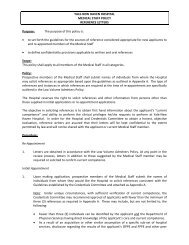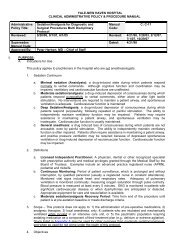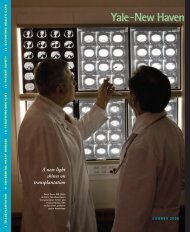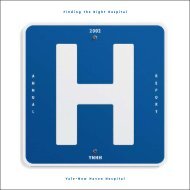Medical Staff Education Reading Materials - Yale-New Haven Hospital
Medical Staff Education Reading Materials - Yale-New Haven Hospital
Medical Staff Education Reading Materials - Yale-New Haven Hospital
You also want an ePaper? Increase the reach of your titles
YUMPU automatically turns print PDFs into web optimized ePapers that Google loves.
3. Follow proper procedures as outlined in the spill kit, Material Safety Data Sheet,<br />
Pharmacy and the department.<br />
4. Report all contact incidents to OHS and complete a "Supervisor's Report of Employee<br />
Accident/Injury" (F-1797) or Incident Report.<br />
C. MAJOR CHEMICAL SPILLS:<br />
1. Phone "155" to report the spill - The Page Operator will sound the "Order Number<br />
One" and begin notification.<br />
2. Remove patients and/or employees from immediate danger.<br />
3. Evacuate the area, as needed, under the supervision of the most senior staff.<br />
4. Follow department-specific instructions.<br />
D. RADIATION ACCIDENTS:<br />
1. Phone "155" to report the spill / discovery of radioactive material - The Page<br />
Operator will sound the "Order Number One" and begin notification.<br />
2. Injured and possibly contaminated persons should be transported to the Emergency<br />
Department under the direction of the area supervisor.<br />
3. Evacuate the area under the direction of the most senior staff upon consultation with<br />
<strong>Hospital</strong>, University, and/or City personnel.<br />
4. Follow department-specific instructions.<br />
E. BIOLOGICAL ACCIDENT:<br />
1. Phone Epidemiology and Infection Control (8-4634) for initial detection -<br />
Epidemiology and Infection Control will notify Administration and others.<br />
2. Assist with patient care as directed by area supervisor, <strong>Hospital</strong> Epidemiologist/designee,<br />
etc.<br />
3. Use proper precautions as directed by <strong>Hospital</strong> Epidemiology and appropriate<br />
administrators.<br />
4. Follow department-specific instructions.<br />
OXYGEN SAFETY<br />
A. SAFE OXYGEN HANDLING AND STORAGE<br />
Oxygen gas is contained in trad itional green, 30 lb . steel tanks or cylinders . As oxygen is a<br />
hazardous chemical, each tank MUST be labeled. All gases for medical use are contained in colorcoded<br />
tanks; however ALWAYS READ THE LABEL and confirm that the tank you are going to use<br />
does contain oxygen.<br />
Oxygen tanks that are con sidered “in use” (regulator attached) should be s tored in a rack th at is<br />
secured to a wall or carrier in an upright position with the regulator off. If an oxygen tank is empty or<br />
not in use it must be stored in the “Oxygen Tank Storage Cabinet” that is found in all patient care<br />
areas. Oxygen tanks sho uld never be stored lying down. If the tank is stored with the reg ulator<br />
and/or flow meter attached, make sure both the regulator and flow meter are turned OFF. AN<br />
OXYGEN TANK MUST BE STORED WITH THE VALVE CLOSED.<br />
B. OXYGEN AND FIRE DANGER<br />
An intentional oxygen shut-off should only happen in the event of a major fire emergency or leak in<br />
the system. While oxygen itself is not flammable or explosive, it will feed a fire and cause it to burn<br />
hotter and faster. If you discover a fire in a patient room, shut off the oxygen at the wall (turn off the<br />
flow meter), if possible. If you are unable to do this, rescue the patient from the room (activate the<br />
“R.A.C.E.” protocol), and call for the patient’s nurse and a Respiratory Therapist.<br />
ONLY A RESPIRATORY THERAPIST AND/OR PLANT ENGINEERING PERSONNEL SHOULD<br />
SHUT OFF THE FLOOR OR ZONE OXY GEN AFTER ASSESSING THE CONSEQUENCES.<br />
10


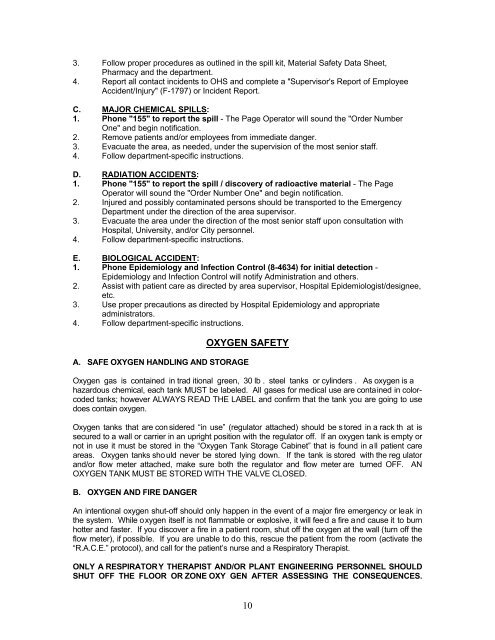



![Annual Report Donor Listings [pdf] - Yale-New Haven Hospital](https://img.yumpu.com/49673575/1/190x245/annual-report-donor-listings-pdf-yale-new-haven-hospital.jpg?quality=85)

